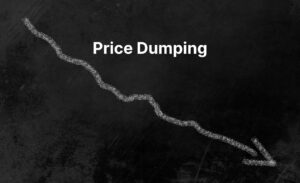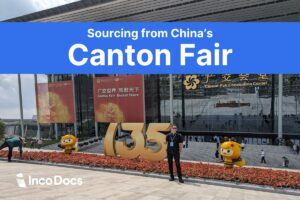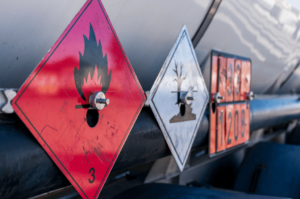Are you looking at buying or selling goods from International suppliers or buyers?
Before proceeding with an International trade transaction and shipment, each party must have a good understanding of the global supply chain risk that is involved.
In this article, we discuss the important elements of risk that must be understood, particularly focusing on supply chain risk management. We provide insight on how supply chain parties can complete satisfactory due diligence to reduce risk and exposure when conducting business Internationally.
Various Elements of Risk Along the Import Export Supply Chain
The first thing to understand, is that conducting business with International companies brings a higher level of risk, compared to dealing with suppliers or customers within your own domestic market. Buying or selling Internationally is a a much more complex process with many more moving parts.
Global trade must involve trust between suppliers and supply chain partners, a level of due diligence, and include a solid understanding of all of the potential risks, underscoring the importance of strategic supply chain management, starting from sourcing suppliers, all the way through to delivery of goods to the final location.
There are many aspects of risk that must be considered, from sourcing new suppliers, purchase order & proforma invoice or sales contracts, transporting goods along the supply chain, applicable insurances, environmental risk, currency fluctuations and market conditions, to name a few.
Without thorough research and planning, you can open your business up to unnecessary risks which can have a severe negative impact on your business.
Establishing Trust with International Buyers and Suppliers
Sourcing new suppliers and buyers is the most critical step in reducing risk in global trade. If you’re not dealing with legitimate and trusted companies, things can go wrong from the very beginning.
Establishing trust takes time and involves each party clearly and respectfully communicating their requirements, to understand if a successful business relationship can be made.
Company Due Diligence
How do buyers know if their potential supplier is from a legitimate company and has the right intentions to create a long term business relationship? At the very beginning, the party risk is more on the buyer’s side, so buyers should understand if the supplier is the right company to deal with.
Buyers should look into the supplier company’s background information as part of their risk management strategies, verifying crucial details such as company registration, director information, shareholders, and location to ensure a secure and reliable trade partnership. There are many companies that provide supplier verification services to provide this information to verify potential International suppliers.
You can view a list of 250 Country profiles here, to understand economic, trade and commercial profiles.
Another risk to consider is how many suppliers or buyers should you deal with? If an importer relies on only 1 supplier to operate and grow their business, if there are issues with the supplier then it can cause big problems for the buyer quite quickly. In this case, dealing with multiple suppliers will reduce some of the supplier and product risk.
Clear Communications
When communicating with International companies, its important that the buyer’s product requirements are clearly understood by the supplier. There are almost always differences in languages and cultures, so clear respectful communication is key to understanding if a supplier can manufacture goods to the buyer’s specifications.
It’s important to remember that manufacturing products involves alot of different processes and materials, one product can be manufactured in many different ways. The buyer should clearly state the type of products they are wanting, from the materials, sizes, specifications, colours, through to quantities, packaging, standards (if applicable), Intellectual Property and any other specific requirements.
Throughout these discussions, both parties should clearly understand what Incoterms® are and how they work. Put simply, Incoterms® are the selling terms that the buyer and seller of goods both agree to during international transactions. These rules are accepted by governments and legal authorities around the world. Understanding Incoterms® is a vital part of International Trade because they clearly state which tasks, costs and risks are associated with the buyer and the seller. Learn more about Incoterms® and how to apply the right Incoterm® for your business.
The communications process must not be rushed, clearly communicating as much information as possible will avoid confusion and reduce the risk of the wrong type or quality of products to be supplied.
You can listen to this podcast, where Heather from Sourcing Playground explains how buyers should correctly source imported goods from online marketplaces such as Alibaba, Made-In-China, Global Sources others. Heather gives key tips on how to correctly give suppliers detailed product information, how to compare supplier’s quotations and product specifications, overcome language and cultural barriers, understand if you are dealing with a factory or trading company and how to negotiate pricing with suppliers.
Cybersecurity: important for modern supply chain risk management
In today’s interconnected global market, cybersecurity has emerged as a critical component of supply chain risk management. With the increasing reliance on digital technologies and data-driven processes in supply chain operations, companies face heightened risks from cyber threats such as data breaches, malware attacks, and compromised software or hardware from suppliers.
This is a potential vulnerability that can lead to significant disruptions, including loss of sensitive information, operational downtime, and damage to brand reputation. Therefore, it is essential for businesses to implement robust cybersecurity measures, conduct regular risk assessments, and ensure that their suppliers adhere to stringent information security standards. By prioritizing cybersecurity, companies can safeguard their supply chains against digital threats and maintain the integrity of their operations.”
Understand Global Trade Payment Terms and Risk
As mentioned, there is considerable risk involved in global trade. At some point the exporter will have to decide at what point they require full payment of goods. Some payment terms will be more favorable to the exporter or to the importer, it’s up to the 2 parties to negotiate and agree on these critical trade terms.
If there has been a good trading history between the buyer and seller and a high level of trust has been built up over time, then the seller may agree to a payment term that is more favorable to the importer.
Importers and exporters must understand the different payment terms that are available and the costs & risks that are associated with each party. Read the article to understand the different types of payment terms that buyers and sellers can agree to for the sale of goods.
Shipping Methods and Shipping Container Specifications
There are 4 modes of transport along the International Supply Chain. Goods can be transported via Sea, Air, Road or Rail. Multiple modes of transport will most likely be used for 1 single shipment to get products delivered to International locations.
The mode of transport and the type of shipping container used mainly depends on the product’s overall packing sizes, cubic measurement or total weight. Products can be shipped via LCL cargo, FCL Cargo, Breakbulk and other methods, which will bring various elements of risk. There are many different types of shipping containers available to load and transport goods. Read more about shipping methods and shipping container specifications here.
Landed Costs and Foreign Currency Exchange Fluctuation Risk
Firstly, importers should accurately understand the landed cost of the products that they are looking to import. Importers are faced with dozens of additional costs, fees and charges involved with importing products through to the final location. It’s imperative that buyers understand the actual final costs of imported products in advance, to make smart decisions for their business.
If businesses do not take the time to understand their landed cost, they could be faced with unexpected fees and charges which could make importing the products unviable. Calculating the landed cost requires an understanding of some key costs and correctly applying them to each product to get the final landed cost per item.
Read this guide on how to calculate the landed cost and sell pricing of imported products here.
The exporter will usually state the currency that they would like to sell their goods to their buyers. For quite a long time, the vast majority of global trade has been processed in US Dollars. So when the buyer’s currency is different, the buyer will have to exchange currencies at the time of payment.
But as we know, global currencies consistently fluctuate. What happens when the USD and local currencies fluctuate? Keep in mind that the time (and currency) varies between when a sales contract is confirmed, the goods are shipped on board and the date of arrival into the country of import. Importers and exporters can keep an eye on currency exchange rates using companies such as XE, as one example.
Reduce your risk by understanding how your landed costs and profit margins are affected by the rising or falling exchange rate. Each shipment will have a different exchange rate and different landed cost, so importers must understand at what point would a change of costs affect their sell pricing?
Purchase Order & Proforma Invoice or Sales Contract Risk
If each party is satisfied with the communications, product details and pricing discussions so far, the next step is to detail everything on paper.
International trade involves cross-border trade, which involves multiple Country law. Countersigned Proforma Invoices, Sales Contracts and Purchase Orders represent a legally binding agreement between the buyer and seller. If there are any problems or disputes relating to the order or shipments, these documents will be referred to in a court of law. If in doubt, you should request professional legal advice on the details included in your Purchase Order and Sales Contracts.
Purchase Order and Proforma Invoice or Sales Contracts should include as much details as possible. Contracts usually include buyer and seller details, specific details of the products to be sold, quantities, lead time, quality control, currency, Incoterm® & place, shipping details, payment terms and any additional terms & conditions of trade. Both the buyer and seller should counter-sign and stamp each document to put the official agreement in place to reduce risk. Read more about Proforma Invoices and Purchase Order documents here.
SWIFT International TT Payments and other Payment Methods Risk
When the terms in the contracts are agreed and signed, the buyer will need to make an International payment to the supplier.
Buyers most often make International payments by Telegraphic Transfer (T/T) to send money to overseas suppliers. However, there are different payment methods that buyers can use to transfer money Internationally. International money transfers usually require exchanging currencies and come with costs and fees. To reduce risk, buyers should always avoid paying suppliers 100% in advance, but rather negotiate split deposit and balance payment terms.
Read this article to understand payment options and how to secure the best foreign exchange rates for International payments to suppliers.
Manufacturing & Quality Control Risk
Just because importers and exporters have completed company due diligence checks and purchase order & sales contracts, don’t assume that you will get exactly what has been agreed. It’s important that buyers must continually communicate with suppliers to check in on progress and different stages of production.
For additional security and for detailed quality control checks, buyers may choose to undertake an independent product inspection from a 3rd party. These companies can be engaged to thoroughly check, measure, test and verify the quality of the products, during or after production. SGS is one such company that provides these services through their vast International network.
To reduce risk, it’s best to receive a detailed independent product inspection report that includes all photos and details of the goods that are being manufactured. If inconsistencies or faults are found, it gives the importer and exporter a chance to negotiate the best outcome, before the goods are exported around the world.
An important factor that can be easily overlooked is the type and quality of the export packaging that is used to package the goods ready for export. Products are manufactured in many different shapes and sizes, and some are more fragile than others. They can be packaged on various sized pallets, crates and other types of packaging.
The finished packages are almost always loaded inside shipping containers along with other sized and shaped cargo, which if not properly packaged and secured, can cause products to be damaged when transported along the various modes of the global supply chain.
Understanding Risk During the Global Logistics & Transport Process
The movement of goods through the global supply chain brings many different elements of risk. Shipping goods from a supplier, all the way through to the final location most often involved several modes of transport, loading, unloading or consolidation of goods.
As mentioned above, the finished products must be packaged in strong export packaging to reduce the risk of damage throughout the supply chain.
Keep in mind that products may be transported by multiple modes of transport, including Road, Rail, Air or Sea, along multiple routes. The packages may be transported by various trucks, trains, aircraft or shipping vessels along multiple routes, where they can be constantly loaded, unloaded and re-loaded, stored at various ports, before finally reaching the final destination.
Other factors that can lead to supply chain disruption include natural disasters, labor strikes, and various geopolitical influences.
Make sure that you understand how the Bill of Lading document works along the supply chain. A Bill of Lading (B/L or BoL) document is an extremely important document involved in the shipping and logistics industry. A Bill of Lading is a document that the Carrier of goods issues to the “Shipper” of the goods.
It’s a document to provide evidence or proof of shipment. This is extremely important in International Trade as it provides ‘title’ as to who legally owns the cargo. Moreover, the Bill of Lading acts as evidence of Contract of Carriage, receipt of goods and document of Title to the goods.
Cargo theft and tampering is also a risk to consider. The level of risk varies upon the actual transport route that your shipment is taken and which countries that your shipment passes through.
Dealing with an experienced freight forwarder will help you to get better insight and understanding into the movement of your goods. Read this article on choosing the right freight forwarder for your business.
Geo-Political Risks to Consider
On top of what has been mentioned above, there are alot of Geo-political risks to consider along the global supply chain.
Geo-political influences can significantly impact the import-export process. Some things to consider include trade wars, fluctuations of tariffs, trade sanctions, political instability, regulatory changes, economic instabilities and diplomatic relations.
Cargo Insurance Risk
Due to all of the different modes of transport mentioned above, the risk of cargo damage can be quite high. Its a smart move to make sure that you have the appropriate transport insurance in place.
Remember that the cost and risk transfers based on the Incoterm® that the products are sold on. For example, if the goods are sold on Free On Board FOB terms, then the buyer will assume the risk when the goods are loaded on board the vessel for export. The buyer should get appropriate insurance in place that will cover the transport of goods through to the final location.
There are many specialist cargo insurance companies that provide specific insurance cover based on the details of your shipments. It’s best to speak to a specialist insurance provider that is already familiar with the complexities of the global supply chain so that they can provide you with rates to cover your shipments and transport operations in full.
Listen to this podcast which gives listeners an understanding of how marine insurance works, why it’s important for shippers to insure cargo, and who should cover insurance based on the agreed Incoterm®.
The importer should also consider the risk of damages that imported products may cause when sold in the local market. In some cases, importers are deemed as the manufacturer of goods and are liable for the products that are sold within that country. Insurance companies can offer product indemnity insurance to protect your business from such risks.
Customs Clearance Risk
There are various factors to consider to reduce the risk of having issues throughout the customs clearance process.
Firstly, buyers and sellers must understand if the products to be shipped are approved to be imported into the destination country. For example, some products such as food & agricultural products must have pre-import approval so that they can be cleared into the country of import, some products have tight restrictions and can not be imported into some countries.
To get detailed information, have a conversation with your freight forwarder or customs broker, to discuss and understand HS or HTS codes and any other import regulations.
Shippers must correctly identify and classify goods so that the correct import duty rate will be applied in the country of import. Therefore, if the incorrect classification of goods is made then shippers can be paying a higher or lower rate of import duty. As a result, customs authorities will issue fines and financial penalties for incorrect classification of goods. On top of that, additional costs for wharf and storage charges can also be incurred if there are delays due to incorrect classification.
Another factor to consider is the export documentation. To avoid shipment demurrage fees in the country of destination, shippers should provide clear, detailed shipping documentation through to the importer, then freight forwarder or customs broker that will be clearing the shipment into the country.
Shippers have to provide a set of shipping documentation to the importer, for the customs clearance process. At times, suppliers mess around with various templates and can provide inaccurate, incomplete documentation, or fail to provide certain shipping documents that are required.
If complete, compliant shipping documentation is not provided in time, it will cause costly delays throughout the customs clearance process. If shipments are not cleared in time, they can sit at the port and incur demurrage fees daily. Importers should follow up exporters for the Bill of Lading and other shipping documentation as soon as the vessel has left the port.
To understand the different templates and formats that are required throughout this process, view and download a range of export documentation templates here. Shippers can use IncoDocs to ensure they create clear, compliant export documentation to reduce the risk of fines and delays in the customs clearance process.
If the country of export and final country of import have a current Free Trade Agreement (FTA) in place, this can reduce or eliminate import duties and tariffs in the country of import. If a Free Trade Agreement is in place, the shipper will need to provide a Certificate of Origin document to the importer, to use in the customs clearance process. Read how Certificates of Origin work here.
Sales, Marketing, Competition and Market Condition Risk
There are several risks involved in selling products in a domestic market. Economies and business is always evolving, a changing landscape can have an impact on sales and distribution.
Some factors to consider include market saturation & overcrowded markets, changing consumer preferences & demand, changing regulatory environments, currency exchange fluctuation and landed costs, counterfeit products and Intellectual Property rights.
Think through all of the potential sales and marketing channels that can work for your business. There are a variety of B2B or B2C online and offline sales and marketing channels that can help you achieve your goals. Utilizing a variety of sales and distribution channels will allow companies to keep selling their products should one channel experience negative impacts.
A business having access to cash assets, rather than relying on debt resources and credit accounts can greatly help to mitigate the various risks associated with its operations. Having ‘cash in the bank’ provides immediate liquidity in times of unexpected downturns or when unforeseen expenses arise.
Cash assets also gives businesses the flexibility to seize new opportunities, make strategic investments, or pivot their business model quickly, without having to wait for loan approvals and working through additional red tape.
Businesses involved in the import export process need to constantly assess and adapt to these changing market conditions. Having a good understanding of the landscape and having a solid strategic plan will help businesses navigate these challenges and help to reduce a level of risk.
Conclusion
In conclusion, the global nature of the import export process brings an abundance of additional processes, challenges, and risks for importers and exporters, highlighting the critical role of supply chain management along the supply chain. Implementing effective risk management strategies is key to harnessing these opportunities, allowing buyers and sellers to expand their reach and seize new opportunities to meet their goals.
Without taking the time to research and understand all of the potential risks involved along the supply chain, businesses will leave themselves exposed, which could have a dramatic impact on the future of a business.
Take the time to do extensive research, seek professional advice and speak to as many different parties as possible along the supply chain to gather a solid understanding of the level of trust, risk and processes that will be faced when doing business Internationally.
Documenting everything, drafting and communicating a plan will help to mitigate risk and give your business the best chance to thrive in global trade.







